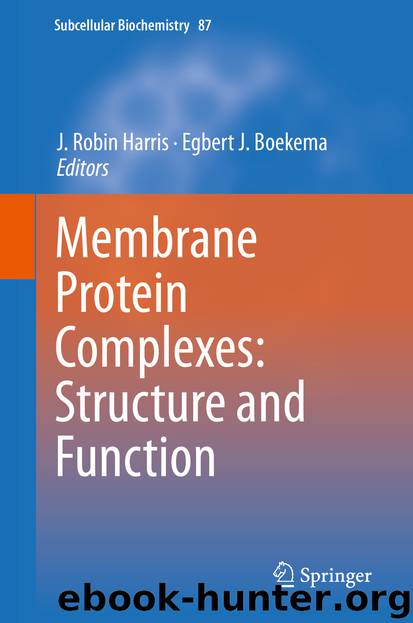Membrane Protein Complexes: Structure and Function by J. Robin Harris & Egbert J. Boekema

Author:J. Robin Harris & Egbert J. Boekema
Language: eng
Format: epub
Publisher: Springer Singapore, Singapore
8.2 SERCA Isoform Diversity and Tissue Distribution
Our detailed understanding of the structure and function of P-type ATPases is attributable to SERCA1a, the isoform present in and easily isolated from rabbit fast twitch skeletal muscle. It is presumed that the structure and function of SERCA1a is generally reflective of the entire family of P-type ATPases (Moller et al. 2010). Calcium pumps appear to be present in all living organisms from prokaryotes to mammals, though our understanding of prokaryotic calcium pumps remains rudimentary. Of the eukaryotic calcium pumps, three multigene families and nine members are currently known. There are three genes that encode SERCA pumps (SERCA1-3 or ATP2A1-3), four that encode plasma membrane calcium pumps (PMCA1-4 or ATP2B1-4), and two that encode secretory pathway calcium pumps (SPCA1-2 or ATPC2A1-2). These genes give rise to more than 40 different splice variants, which results in an impressive diversification of form, function, regulation, and physiological role (Brini et al. 2012).
In vertebrates, SERCA paralogues are encoded by a family of three genes – SERCA1, SERCA2, and SERCA3 – located on three different chromosomes. This family is highly conserved, with SERCA1 and SERCA2 being ~84% identical and SERCA3 being ~75% identical to either of the other paralogues. The isoform diversity of SERCA is amplified by alternative splicing of transcripts, which occur mainly in the C-terminus of the protein. These splicing variations give rise to thirteen currently known isoforms (SERCA1a-b, SERCA2a-d, and SERCA3a-f) (Wuytack et al. 2002; Dally et al. 2010). These SERCA isoforms exhibit both tissue and developmental specificity, reflecting their diversified functionality. The SERCA1 gene encodes two spliced variants primarily expressed in adult (SERCA1a; 994 residues) and fetal-neonatal (SERCA1b; 1001 residues) fast-twitch skeletal muscle. The SERCA1a and SERCA1b isoforms are functionally equivalent and differ by only seven additional residues at the C-terminus. While there is no specific structure or function associated with the extended C-terminus of SERCA1b, it is highly charged and may play a role in skeletal muscle development (Kosa et al. 2015). It is also interesting to consider that the C-terminus of the related sodium pump inserts into the membrane domain and modulates sodium affinity (Toustrup-Jensen et al. 2009). Thus, the short extension found in SERCA1b may modulate function during the developmental switch from fetal to adult skeletal muscle.
The SERCA2 gene is best known for encoding both the ubiquitous and cardiac-specific isoforms of SERCA (Vangheluwe et al. 2005). In all, four isoforms (SERCA2a-d) are generated by alternative splicing of the SERCA2 gene transcript. SERCA2b is a ubiquitous isoform expressed in all cell types, whereas SERCA2a is restricted to cardiac muscle, slow-twitch skeletal muscle and smooth muscle cells. In humans, SERCA2a encodes for a 997 amino acid protein and SERCA2b for a 1042 amino acid protein. These two isoforms differ by an unusual addition of 45 amino acids at the C-terminus, which gives SERCA2b an 11th transmembrane helix and places the C-terminus on the opposite side of the membrane in the lumen of the SR. The luminal tail and 11th transmembrane helix of SERCA2b imbue the highest calcium affinity amongst the SERCA isoforms (Gorski et al.
Download
This site does not store any files on its server. We only index and link to content provided by other sites. Please contact the content providers to delete copyright contents if any and email us, we'll remove relevant links or contents immediately.
| Automotive | Engineering |
| Transportation |
Whiskies Galore by Ian Buxton(41529)
Introduction to Aircraft Design (Cambridge Aerospace Series) by John P. Fielding(32888)
Small Unmanned Fixed-wing Aircraft Design by Andrew J. Keane Andras Sobester James P. Scanlan & András Sóbester & James P. Scanlan(32573)
Craft Beer for the Homebrewer by Michael Agnew(17933)
Turbulence by E. J. Noyes(7700)
The Complete Stick Figure Physics Tutorials by Allen Sarah(7138)
Kaplan MCAT General Chemistry Review by Kaplan(6595)
The Thirst by Nesbo Jo(6436)
Bad Blood by John Carreyrou(6274)
Modelling of Convective Heat and Mass Transfer in Rotating Flows by Igor V. Shevchuk(6222)
Learning SQL by Alan Beaulieu(6035)
Weapons of Math Destruction by Cathy O'Neil(5829)
Man-made Catastrophes and Risk Information Concealment by Dmitry Chernov & Didier Sornette(5646)
Digital Minimalism by Cal Newport;(5389)
Life 3.0: Being Human in the Age of Artificial Intelligence by Tegmark Max(5184)
iGen by Jean M. Twenge(5161)
Secrets of Antigravity Propulsion: Tesla, UFOs, and Classified Aerospace Technology by Ph.D. Paul A. Laviolette(4990)
Design of Trajectory Optimization Approach for Space Maneuver Vehicle Skip Entry Problems by Runqi Chai & Al Savvaris & Antonios Tsourdos & Senchun Chai(4839)
Electronic Devices & Circuits by Jacob Millman & Christos C. Halkias(4748)
